-
About
- About Listly
- Community & Support
- Howto
- Chrome Extension
- Bookmarklet
- WordPress Plugin
- Listly Premium
- Privacy
- Terms
- DMCA Copyright
- © 2010-2025 Boomy Labs

Listly by Cryotos CMMS Software

Discover the 5 Key Stages of Asset Lifecycle Management and Best Practices: Streamline Your Asset Management from Acquisition to Disposal. Effective asset lifecycle management is crucial for businesses seeking to optimize asset performance, reduce costs, and maximize returns. Understanding the five key stages of asset lifecycle management and implementing best practices can make a significant difference in your organization's success.

Every asset in an organization has a lifecycle, whether it's a piece of manufacturing equipment, a vehicle, a building, or an IT system. Properly managing this lifecycle from acquisition to disposal is key to maximizing asset value and, in turn, operational efficiency and profitability; This is what Asset Lifecycle Management (ALM) is all about. Let's delve into the steps involved in maximizing asset value with ALM.

The manufacturing industry is undeniably intense. From production demands to tight deadlines, every piece of the puzzle matters, especially when it comes to maintenance. Maintenance costs can quickly accumulate, impacting the bottom line of a manufacturing business. However, by implementing effective strategies bolstered by the power of Maintenance Management Software (MMS), these costs can be significantly reduced.

Reliability Centered Maintenance (RCM) is a systematic approach used in industrial settings to optimize maintenance strategies and ensure the reliability and performance of critical assets and systems
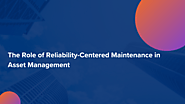
I. Introduction Reliability Centered Maintenance (RCM) is a systematic approach to maintenance planning that prioritizes the reliability of assets and systems. It is a cornerstone of effective asset management, helping organizations optimize asset performance, reduce maintenance costs, and improve operational efficiency. This blog post will delve into the role of RCM in asset management, exploring…
In the complex world of maintenance management, the ability to effectively manage system failures is a critical aspect of ensuring operational efficiency and reliability. One methodology that has proven to be invaluable in this regard is FRACAS, an acronym for Failure Reporting, Analysis, and Corrective Action System. This comprehensive guide aims to provide an in-depth understanding of FRACAS, its process, and how to successfully implement it within your organization.

"The Role of IoT in Modern Maintenance Management" provides a concise yet insightful overview of the significant impact of the Internet of Things (IoT) on maintenance practices. Explore how IoT technology has revolutionized maintenance management by enabling real-time data collection,...

In the digital transformation era, businesses across various industries constantly seek innovative solutions to optimize their operations. One such area that has seen significant technological advancements is asset maintenance. The importance of asset maintenance in industries such as manufacturing, healthcare, and oil and gas cannot be overstated. It ensures the smooth operation of equipment and extends its lifespan, thereby saving costs in the long run.

Introduction Proactive maintenance is a strategic approach that focuses on preventing equipment failures and reducing downtime. It involves actively monitoring and maintaining assets based on their condition and anticipated needs rather than waiting for breakdowns to occur. This approach is significant in improving equipment reliability, enhancing operational efficiency, and reducing maintenance costs.

How to Use Root Cause Analysis Tools in Maintenance - Discover the power of Root Cause Analysis (RCA) tools in maintenance management. In this informative guide, we explore the step-by-step process of utilizing RCA to identify the underlying causes of equipment failures and malfunctions. Learn how to effectively apply various RCA techniques, such as Fishbone Diagrams, 5 Whys, and Fault Tree Analysis, to uncover the root causes and implement targeted solutions.

In today's rapidly evolving technological landscape, the concept of Industry 4.0 has emerged as a significant driver of innovation and transformation across various industries. As part of this revolution, Asset Maintenance Management has taken center stage, aiming to optimize maintenance processes, improve equipment reliability, and enhance operational efficiency.

In today's technologically advanced world, businesses are constantly seeking ways to improve their maintenance processes and optimize asset performance. One approach that has gained significant attention is IoT-driven corrective maintenance. By leveraging the power of the Internet of Things (IoT), organizations can enhance their maintenance efficiency and effectiveness.

Prioritizing and organizing work orders is essential for effective maintenance operations. By establishing clear priority levels, utilizing a CMMS, implementing a maintenance strategy, considering resource availability, collaborating with stakeholders, adopting data-driven approaches, and regularly reviewing priorities, organizations can optimize their work order management processes.

In today's industrial landscape, the well-being of workers and adherence to Occupational Safety and Health Administration (OSHA) regulations are paramount. Organizations are increasingly leveraging technology to ensure worker safety and comply with OSHA standards. One such technology is Computerized Maintenance Management Systems (CMMS), which plays a pivotal role in creating a safe work environment. This blog delves into the importance of worker safety and OSHA regulations.

Cryotos CMMS is a maintenance management system, which supports the complete workflow and operations of the maintenance department of an organization thereby reducing the downtime of machines to marginal level. We are specialized in Asset Management and Facility Management.

In today's fast-paced and competitive business landscape, equipment reliability, and operational efficiency play a critical role in the success of organizations across industries. Effective equipment maintenance is essential to ensure optimal performance, minimize downtime, and maximize productivity. This blog post explores the top 10 benefits of equipment maintenance solutions, powerful tools designed to streamline maintenance processes and revolutionize how organizations manage their assets.
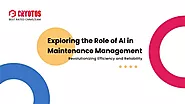
Discover the transformative potential of Artificial Intelligence (AI) in maintenance management with our insightful exploration. In this engaging article, we delve into the innovative ways AI is revolutionizing maintenance practices across industries. From predictive maintenance and anomaly detection to optimizing asset performance and streamlining workflows, AI is reshaping the maintenance landscape.

Breakdown maintenance, also known as reactive maintenance, refers to the strategy of repairing equipment and machinery only after it has broken down or malfunctioned. This approach is most suitable for non-critical assets where downtime doesn't significantly impact operations or costs. While it can be cost-effective in the short term, relying solely on breakdown maintenance can lead to higher long-term repair costs, increased downtime, and potential operational disruptions.

The oil and gas industry operates in a challenging environment where the reliability and performance of equipment are crucial for smooth operations and overall success. Unplanned downtime, equipment failures, and safety hazards can have severe consequences, leading to financial losses, production delays, and potential risks to personnel and the environment. To mitigate these risks and optimize maintenance practices, the industry is increasingly turning to predictive maintenance.
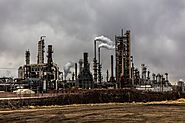
In today's industrial landscape, maintaining equipment reliability and performance is crucial for the success of organizations across various sectors. Preventive maintenance strategies play a significant role in achieving these objectives. Among the various techniques available, oil analysis stands out as a proactive approach that offers valuable insights into equipment health and aids in preventing costly breakdowns.

In the not-so-distant past, maintenance practices were primarily reactive in nature. Organizations would wait for equipment or machinery to break down before taking any action. This approach often resulted in costly downtime, unexpected failures, and increased maintenance expenses. The lack of real-time monitoring and data analysis made it challenging for businesses to predict and prevent potential issues.

Corrective maintenance is a type of maintenance strategy that focuses on fixing assets or equipment after they have failed or broken down. Unlike preventive maintenance, which aims to prevent failures through regular inspections and maintenance tasks, corrective maintenance is reactive and addresses issues as they arise.
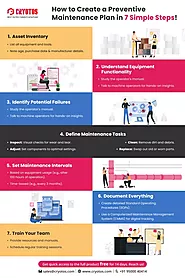
Boost Efficiency & Reliability with a Proactive Approach! Discover the Step-by-Step Guide on How to Create a Preventive Maintenance Plan in 7 Simple Steps! Are unexpected breakdowns and costly downtime impacting your business operations? Don't wait for equipment...
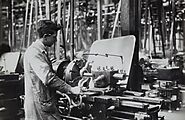
Asset reliability ensures smooth industrial operations. Reliable assets lead to consistent production output and streamlined processes, increasing productivity and efficiency. Downtime caused by asset failures can disrupt production schedules, leading to financial losses and decreased efficiency.
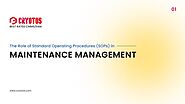
Standard Operating Procedures (SOPs) are systematic, documented processes or sets of steps that guide routine operations and tasks. In the realm of maintenance management, SOPs play a pivotal role in ensuring that maintenance tasks are performed consistently, efficiently, and safely. They provide a standardized approach to critical procedures, ensuring that all maintenance personnel have clear and concise instructions, reducing variability in task execution.